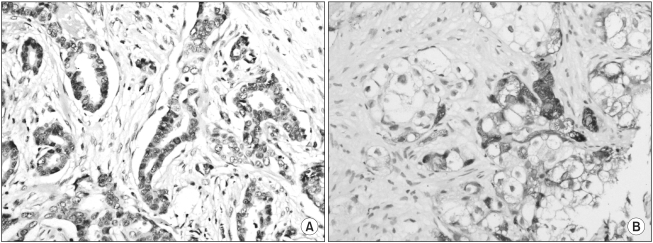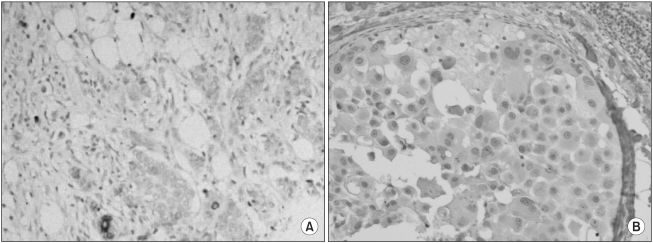Cancer Res Treat.
2005 Aug;37(4):241-246.
The Immunoexpressions and Prognostic Significance of Inhibin Alpha and Beta Human Chorionic Gonadotrophins (hCG) in Breast Carcinomas
- Affiliations
-
- 1Department of Pathology, The Catholic University of Korea College of Medicine, Seoul, Korea. changed@catholic.ac.kr
- 2Department of General Surgery, The Catholic University of Korea College of Medicine, Seoul, Korea.
Abstract
- PURPOSE
Pregnancy and hCG treatments are considered essential for inhibiting breast cancer. The effect of hCG is accompanied by the synthesis of inhibin, a transforming growth factor involved in cell differentiation and proliferation. Inhibin is considered a tumor suppressor, but its role in the breast is unclear. The aim of this study was to determine the frequency and tissue distribution of the expressions of inhibin-alpha and beta-hCG in breast cancer, and their prognostic relevance with other biological parameters. MATERIALS AND METHODS: 334 of formalin-fixed, paraffin embedded tissue blocks were selected, and then immunostained for inhibin-alpha and beta-hCG. The inhibin-alpha expression was compared with those of beta-hCG, ER, PR and HER-2/neu, as well as the tumor characteristics and recurrences. RESULTS: Inhibin-alpha and beta-hCG were expressed in 87 (26.0%) and 44 cases (13.2%), respectively. Inhibin-alpha was found in 25.1% of infiltrating ductal carcinomas (67/267), 26.7% of intraductal carcinomas (8/30), 33.3% of lobular tumors (3/9), 80.0% of apocrine carcinomas (4/5) and 21.7% of the other types (5/23). Inhibin-alpha was correlated with beta-hCG (p<0.0001), PR (p=0.010) and HER-2/ neu (p=0.021). HCG was focally expressed in the cytoplasm of the conventional types, but the apocrine type displayed diffusely intense cytoplasmic staining, which correlated with histological tumor types (p<0.001). CONCLUSION: Inhibin was significantly correlated with the expressions of hCG, PR and HER-2/neu. Therefore, it might be a useful marker in the prevention and hormonal treatment of breast cancer, such as hCG and progesterone. HCG was expressed significantly higher in the apocrine type than the conventional types, suggesting it can be a useful adjunct in differentiating other cancer types.
MeSH Terms
Figure
Reference
-
1. Russo IH, Russo J. Hormonal approach to breast cancer prevention. J Cell Biochem. 2000; 77(S34):1–6. PMID: 10679811.
Article2. Gupta V, Harkin DP, Kawakubo H, Maheswaran S. Transforming growth factor-β superfamily: evaluation as breast cancer biomarkers and preventive agents. Curr Cancer Drug Targets. 2004; 4:165–182. PMID: 15032667.3. Di Loreto C, Reis FM, Cataldi P, Zuiani C, Luisi S, Beltrami CA, et al. Human mammary gland and breast carcinoma contain immunoreactive inhibin/activin subunits: evidence for a secretion into cystic fluid. Eur J Endocrinol. 1999; 141:190–194. PMID: 10427163.
Article4. Zheng W, Lauchlan SC. Inhibin and activin: their roles in ovarian tumorigenesis and their diagnostic utility in surgical pathology practice. Appl Immuno & Mol Morph. 1999; 7:29–38.
Article5. Robertson DM, Pruysers E, Burger HG, Jobling T, McNeilage J, Healy D. Inhibins and ovarian cancer. Mol Cell Endocrinol. 2004; 225:65–71. PMID: 15451569.
Article6. Reis FM, Luisi S, Carneiro MM, Cobellis L, Federico M, Camargos AF, et al. Activin, inhibin and the human breast. Mol Cell Endocrinol. 2004; 225:77–82. PMID: 15451571.
Article7. Reimer T, Koczan D, Muller H, Friese K, Krause A, Thiesen HJ, et al. Human chorionic gonadotrophin-β transcripts correlate with progesterone receptor values in breast carcinomas. J Mol Endocrinol. 2000; 24:33–41. PMID: 10656995.8. Janssens JP, Verlinden I, Gungor N, Raus J, Michiels L. Protein biomarkers for breast cancer prevention. Eur J Cancer Prev. 2004; 13:307–317. PMID: 15554559.9. Elston CW, Ellis IO. Pathological prognostic factors in breast cancer. I. The value of histological grade in breast cancer: experience from a large study with long-term follow-up. Histopathology. 1991; 19:403–410. PMID: 1757079.
Article10. O'Malley FP, Bane AL. The spectrum of apocrine lesions of the breast. Adv Anat Pathol. 2004; 11:1–9. PMID: 14676636.11. Risbridger GP, Ball EM, Wang H, Mellor SL, Peehl DM. Re-evaluation of inhibin alpha subunit as a tumour suppressor in prostate cancer. Mol Cell Endocrinol. 2004; 225:73–76. PMID: 15451570.12. Agnantis NJ, Patra F, Khaldi L, Filis S. Immunohistochemical expression of subunit beta HCG in breast cancer. Eur J Gynaecol Oncol. 1992; 13:461–466. PMID: 1282101.13. Wachner R, Wittekind C, von Kleist S. Immunohistological localization of beta-HCG in breast carcinomas. Eur J Cancer Clin Oncol. 1984; 20:679–684. PMID: 6203754.14. Chung TS, Kim BG, Cha SJ, Park SI, Lim HM, Park SJ, et al. Expression of topoisomerase II-α and c-erbB-2 in breast cancer. J Korean Breast Cancer Soc. 2002; 5:135–141.
Article15. McCluggage WG, Maxwell P. Adenocarcinomas of various sites may exhibit immunoreactivity with anti-inhibin antibodies. Histopathology. 1999; 35:216–220. PMID: 10469213.
Article16. Robertson DM, Stephenson T, Cahir N, Tsigos A, Pruysers E, Stanton PG, et al. Development of an inhibin alpha subunit ELISA with broad specificity. Mol Cell Endocrinol. 2001; 180:79–86. PMID: 11451575.17. Lewis KA, Gray PC, Blount AL, MacConell LA, Wiater E, Bilezikjian LM, et al. Betaglycan binds inhibin and can mediate functional antagonism of activin signaling. Nature. 2000; 404:411–414. PMID: 10746731.18. Kuida CA, Braunstein GD, Shintaku P, Said JW. Human chorionic gonadotropin expression in lung, breast, and renal carcinomas. Arch Pathol Lab Med. 1988; 112:282–285. PMID: 2449877.19. Guo S, Russo IH, Lareef MH, Russo J. Effect of human chorionic gonadotrophin in the gene expression profile of MCF-7 cells. Int J Oncol. 2004; 24:399–407. PMID: 14719117.
- Full Text Links
- Actions
-
Cited
- CITED
-
- Close
- Share
- Similar articles
-
- Immunohistochemical localization of beta human chorionic gonadotrophin (beta-hCG) in breast carcinomas and its prognostic significance
- Serum biomarkers for predicting pregnancy outcome in women undergoing IVF: human chorionic gonadotropin, progesterone, and inhibin A level at 11 days post-ET
- The significance of first trimester maternal serum alpha-fetoprotein and beta-human chorionic gonadotropin measurements before chorionic cillus sampling
- Predictive Value of Serum beta-hCG Level in Pregnancies following In Vitro Fertilization and Embryo Transfer
- Pulmonary Carcinoma with beta-Human Chorionic Gonadotropin Expression: Further Understanding and Suggestions for This Entity from Six Cases Experience in a Single Institution




